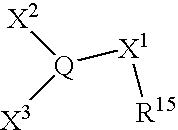Aqueous amphiphilic copolymer emulsions having controlled viscosity and methods for making the same
a copolymer and amphiphilic technology, applied in the field of amphiphilic copolymer emulsions having controlled viscosity, can solve the problems of difficult if not impossible to handle, amphiphilic polymer polymerization poses additional difficulties, and poor control of polymerization kinetics
- Summary
- Abstract
- Description
- Claims
- Application Information
AI Technical Summary
Benefits of technology
Problems solved by technology
Method used
Image
Examples
example 1
(Control): No Mercaptopropionic Acid and 20% Acrylic Acid
[0083]An initial charge of 400 g of water was placed into a 5 liter flask equipped with a stirrer, thermometer, condenser and N2 bubbler, followed by heating the kettle water to 61-63° C. with agitation and a nitrogen purge. Separately, each of the following solutions was prepared:
[0084]1. 800 grams butyl acrylate, 200 grams acrylic acid, 45 grams n-dodecylmercaptan (monomer component);
[0085]2. 360 grams aqueous / surfactant mix comprising of 2.78 percent sodium lauryl sulfate (surfactant) and the balance water.
[0086]3. 2.98g of ammonium persulfate (APS) in 95 grams of water; and,
[0087]4. 2.98 g of sodium bisulfite (NaBS) in 95 grams of water.
[0088]Once the kettle water reached the desired temperature, 1 gram of acetic acid was added, followed by 1.6 grams of a 1% ferrous sulfate solution. Separate co-feeds of the ammonium persulfate (APS) and sodium bisulfite (NaBS) solutions into the flask were started at a rate of 0.5 gram / mi...
example 2
0.5% BOM (Based on Monomer) of Mercaptopropionic acid (3-MPA) and 20% Acrylic Acid
[0091]The procedure of Example 1 was repeated, except that:
[0092]A. Separately, each of the following solutions was prepared:
[0093]1. 800 grams butyl acrylate, 200 grams acrylic acid, 45 grams n-dodecylmercaptan and 5 grams mercaptopropionic acid (monomer and mixed chain transfer agent components).
[0094]2. 360 gram aqueous / surfactant mix comprising of 2.78 percent sodium lauryl sulfate (surfactant) and the balance water.
[0095]3. 2.98 g of ammonium persulfate (APS) in 95 grams of water; and,
[0096]4. 2.98 g of sodium bisulfite (NaBS) in 95 grams of water.
[0097]B. The monomer and mixed chain transfer agent component feed and surfactant component feed were mixed together, passing through an in-line emulsification unit just prior to entering the 5 liter flask.
[0098]Once the feeds were complete, the copolymerization product was cooled to 35 to 40° C. and filtered. The physical measurements on the filtered d...
example 3
(Control): No Mercaptopropionic Acid and 40% Acrylic Acid
[0099]The procedure of Example 1 was repeated, except that:
[0100]A. Separately, each of the following solutions was prepared:
[0101]1. 600 grams butyl acrylate, 400 grams acrylic acid, 45 grams n-dodecylmercaptan.
[0102]2. 360 gram aqueous / surfactant mix comprising of 2.78 percent sodium lauryl sulfate (surfactant) and the balance water.
[0103]3. 2.98 g of ammonium persulfate (APS) in 95 grams of water; and,
[0104]4. 2.98 g of sodium bisulfite (NaBS) in 95 grams of water.
[0105]B. The monomer and mixed chain transfer agent component feed and surfactant component feed were mixed together, passing through an in-line emulsification unit just prior to entering the 5 liter flask. Once the feeds were complete, the copolymerization product was cooled to 35 to 40° C. and filtered. The physical measurements on the filtered dispersion have a range of: pH=1.7-2.1, Solids=49-51%, PS=190-320 nm.
PUM
| Property | Measurement | Unit |
|---|---|---|
| wt. % | aaaaa | aaaaa |
| wt. % | aaaaa | aaaaa |
| wt. % | aaaaa | aaaaa |
Abstract
Description
Claims
Application Information
 Login to View More
Login to View More - R&D
- Intellectual Property
- Life Sciences
- Materials
- Tech Scout
- Unparalleled Data Quality
- Higher Quality Content
- 60% Fewer Hallucinations
Browse by: Latest US Patents, China's latest patents, Technical Efficacy Thesaurus, Application Domain, Technology Topic, Popular Technical Reports.
© 2025 PatSnap. All rights reserved.Legal|Privacy policy|Modern Slavery Act Transparency Statement|Sitemap|About US| Contact US: help@patsnap.com

